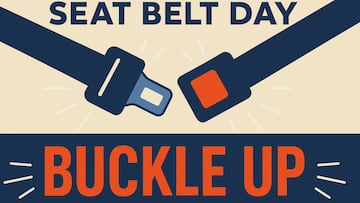National Seat Belt Day: When did it become mandatory to buckle up in the U.S.?
These days we hardly think of the process of buckling up, but it hasn’t always been the case.


While it may surprise you, the story behind National Seatbelt Day begins not with a cop pulling someone over, but with car makers. On January 1 1968, a federal regulation came into force requiring new passenger cars to be equipped with seat belts (though not expressly requiring occupants to use them).
Two decades later, on October 15 1987, actor-turned-president Ronald Reagan proclaimed “National Safety Belt Use Day” in the U.S. to encourage belt use; yet that was just a promotional effort rather than a blanket law.
Which U.S. state was first to introduce seatbelt law?
Federal equipment laws didn’t mean people had to wear the belts. That change came via the states. On December 1 1984, New York State implemented the first U.S. statute requiring drivers and front-seat passengers (and rear-seat children) to buckle up.
From then on, other states followed. By 1996, all states but New Hampshire had laws requiring seat-belt use for drivers / front-seat passengers.
How U.S. seatbelt law looks today:
- The federal government mandates seat belts be installed in new cars, but use-laws are largely state purview
- According to the Governors Highway Safety Association, 35 states + D.C. have primary enforcement belt-laws for front seats (i.e., you can be stopped solely for not buckling)
- Nationwide belt-usage is now high – around 90%+ for front-seats – a major shift from the early 1980s when usage was low (11-14%)
The answer about law requirements depends on level and scope:
- Equipment-only (cars must have belts): 1968 (federal)
- Use-laws (occupants must wear belts): 1984 in New York (first state)
- Universal across states (front-seats drivers/passengers): by mid-1990s
So, while the hardware mandate dates to 1968, the meaningful mandatory use actually began in 1984.
Why does National Seat Belt Day matter?
Decades ago, belt-use was optional, and usage rates were very low. The shift to laws plus enforcement spurred the change. The day marked as National Seat Belt Day (November 14) is about awareness: reminding drivers and passengers that wearing the installed belts matters.
And the laws work: research shows mandatory-use plus primary enforcement yields stronger compliance and fewer fatalities. That said, even with high usage, many crash fatalities involve occupants not buckled.
Related stories
Get your game on! Whether you’re into NFL touchdowns, NBA buzzer-beaters, world-class soccer goals, or MLB home runs, our app has it all.
Dive into live coverage, expert insights, breaking news, exclusive videos, and more – plus, stay updated on the latest in current affairs and entertainment. Download now for all-access coverage, right at your fingertips – anytime, anywhere.
Complete your personal details to comment